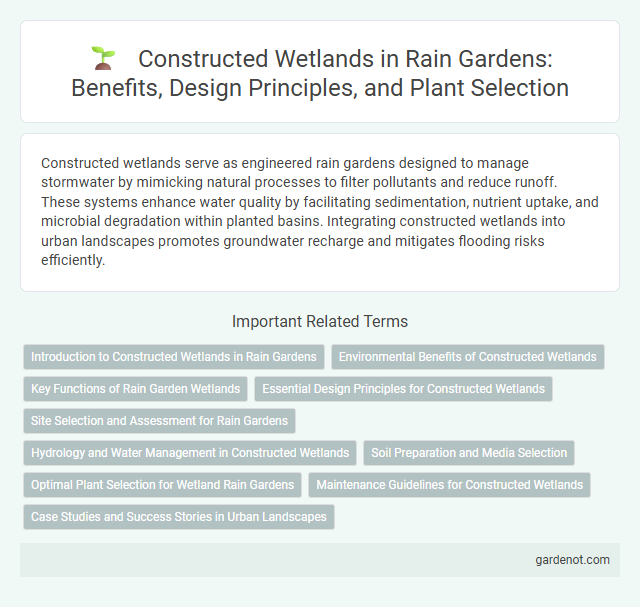Constructed wetlands serve as engineered rain gardens designed to manage stormwater by mimicking natural processes to filter pollutants and reduce runoff. These systems enhance water quality by facilitating sedimentation, nutrient uptake, and microbial degradation within planted basins. Integrating constructed wetlands into urban landscapes promotes groundwater recharge and mitigates flooding risks efficiently.
Introduction to Constructed Wetlands in Rain Gardens
Constructed wetlands in rain gardens function as engineered ecosystems designed to manage stormwater by mimicking natural wetland processes. These systems utilize specific vegetation, soil types, and microbial activity to filter pollutants, enhance groundwater recharge, and reduce runoff volume. Optimal design integrates hydrophytic plants and permeable substrates to maximize nutrient removal and improve water quality in urban environments.
Environmental Benefits of Constructed Wetlands
Constructed wetlands effectively treat stormwater by filtering pollutants and reducing nutrient loads, improving water quality in surrounding ecosystems. They support biodiversity by providing habitat for native flora and fauna, enhancing urban green spaces. These systems also mitigate flood risks through natural water retention and groundwater recharge, contributing to climate resilience.
Key Functions of Rain Garden Wetlands
Rain garden wetlands perform critical functions such as filtering stormwater runoff to remove pollutants including heavy metals, nutrients, and sediment. They provide habitat for diverse aquatic and terrestrial species, enhancing urban biodiversity while supporting natural water cycles through infiltration and evapotranspiration. These wetlands mitigate flooding by storing excess stormwater, reducing peak flow rates, and promoting groundwater recharge in urban environments.
Essential Design Principles for Constructed Wetlands
Constructed wetlands rely on essential design principles such as substrate selection, water flow regulation, and vegetation type to effectively treat stormwater and improve water quality. Proper substrate layers, including sand, gravel, and organic matter, facilitate filtration and microbial activity crucial for pollutant breakdown. Vegetation like reeds and cattails enhance nutrient uptake while maintaining optimal hydrology ensures aerobic and anaerobic zones for contaminant removal.
Site Selection and Assessment for Rain Gardens
Site selection for constructed wetlands in rain gardens requires detailed assessment of soil permeability, topography, and hydrology to ensure optimal water retention and filtration. Soil infiltration tests and slope analysis help determine appropriate locations that prevent waterlogging and promote efficient runoff management. Consider proximity to pollutant sources and existing vegetation to enhance pollutant removal and support native plant growth in the rain garden system.
Hydrology and Water Management in Constructed Wetlands
Constructed wetlands efficiently manage stormwater by mimicking natural hydrology, promoting infiltration, detention, and evapotranspiration to reduce runoff volume and improve water quality. These systems use engineered substrates and vegetation to enhance sedimentation, nutrient uptake, and microbial processes, effectively treating pollutants such as nitrogen, phosphorus, and heavy metals. Hydrological design considerations, including hydraulic retention time and flow path, are critical for optimizing pollutant removal and maintaining wetland health.
Soil Preparation and Media Selection
Constructed wetlands for rain gardens require precise soil preparation to enhance water infiltration and pollutant removal, often involving the removal of compacted soil layers and the addition of organic matter to improve permeability. Media selection is critical, with a common mixture comprising sand, compost, and topsoil that supports microbial activity and plant growth while facilitating effective filtration of stormwater contaminants. Proper soil and media configuration ensures optimal nutrient cycling, pollutant degradation, and water retention within the rain garden ecosystem.
Optimal Plant Selection for Wetland Rain Gardens
Optimal plant selection for constructed wetland rain gardens involves choosing native species with high pollutant uptake and tolerance to fluctuating water levels. Plants such as Carex spp., Juncus effusus, and Typha latifolia excel in nutrient absorption and support microbial communities that enhance water filtration. Selecting diverse, resilient species improves wetland function, promotes biodiversity, and ensures effective stormwater management.
Maintenance Guidelines for Constructed Wetlands
Regular inspection and removal of debris, sediment, and invasive plants are essential to maintain optimal water flow and function in constructed wetlands. Periodic monitoring of water quality parameters, such as nutrient levels and dissolved oxygen, ensures the wetland continues to effectively treat stormwater runoff. Structural components like inlet and outlet devices require routine cleaning and repair to prevent blockages and maintain hydraulic performance.
Case Studies and Success Stories in Urban Landscapes
Constructed wetlands in urban landscapes have demonstrated remarkable success in managing stormwater runoff, improving water quality, and enhancing biodiversity, as highlighted by case studies in cities like Portland and Singapore. These engineered ecosystems effectively reduce pollutants such as nitrogen, phosphorus, and heavy metals through natural filtration processes, supporting sustainable urban water management. Monitoring data from these sites show significant decreases in peak flow rates and pollutant loads, validating constructed wetlands as a resilient green infrastructure solution.
Constructed wetland Infographic

 gardenot.com
gardenot.com